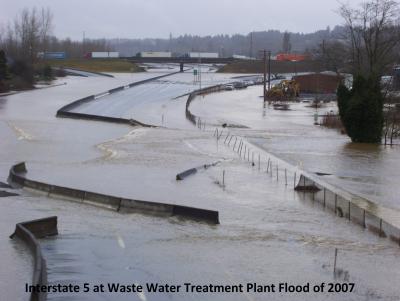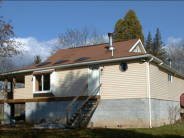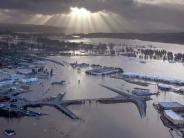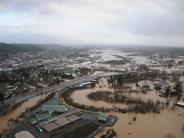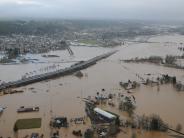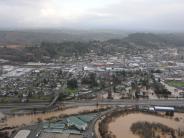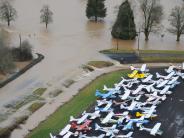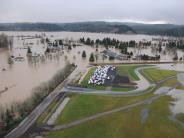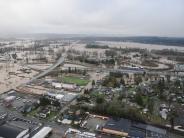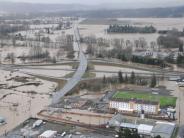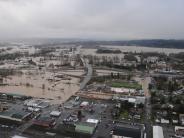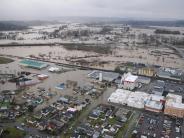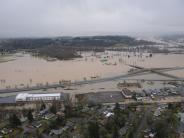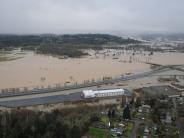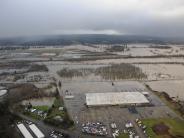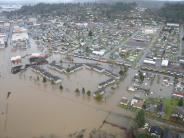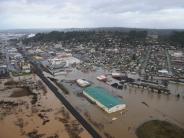- Departments
- Residents
- Business
- Visitors
Flood Information and Elevation Certificates
Flood Information
Flooding in Chehalis is a real hazard. The Chehalis River has flooded more than 18 times in the last 20 years. “Major” floods occurred in 1990, 1996, 2007, 2009, and 2022. You can find more about the Chehalis River Basin and proposed mitigation actions here.
Keep reading for more information about the threat and what you can do to protect yourself, your family, and your property.
BEFORE A FLOOD:
- See Our Flood Hazard for more information on the floodplain and flood hazards in the City. Find out if your property is in a Special Flood Hazard Area or 100 Year Flood Zone using the map below. You can check out river gauge data at the National Weather Service's website. If you see a heavy rain or hear of a flood watch or warning, go to the site. Put in the predicted river stage and see a map of where the flood is predicted to go.
- Prepare yourself, your family, and animals by creating "go bags" or emergency packs containing irreplaceable documents, crucial medications, food, clothes, and other necessary items. You can find example lists in pdf form at the bottom of this page.
- Sign up for Lewis County Alert to receive alerts and information about severe weather and safety issues.
- Protect your property from damage by a flood. This link shows you several things you can do to prevent or minimize damage to your building and its contents. There are ways to modify your building to minimize flood damage. Where flooding is shallow, measures such as small floodwalls, regrading the yard, and floodproofing the walls or utilities can be relatively inexpensive. Where flooding is deep, there may be grants to help pay for elevating or relocating the building. For a detailed overview of retrofitting methods, see FEMA's "Homeowner's Guide to Retrofitting." There is a direct relation between the level of flooding and the cost of flood insurance. You can lower your flood insurance premiums by protecting your property.
- Minimize damage to your property. There are building and grading regulations that are designed to protect your property and prevent you from incidentally causing flood damage to your neighbors. Check with the Building Department (360)345-2229 before you build on, alter, regrade or fill on your property. A permit may be needed to ensure that a project is compliant with all regulations. These regulations are designed to protect your property from flood damage and to make sure you don’t cause a water problem for your neighbors.
- Flood insurance can help cover the cost of damage and help you repair, replace, and rebuild after a storm. Learn about insurance coverage and costs here. Contact your property insurance agent to see if a flood insurance policy would help you. Even if you’re not in the mapped floodplain, you may be subject to flooding from local drainage. In either case, flood insurance can be a good investment because most homeowners insurance policies do not cover damage caused by surface water flooding. Contact your property insurance agent to see if a flood insurance policy would help you. If your insurance agent does not sell flood insurance, you can contact the NFIP Referral Call Center at (888) 379-9531 to request an agent referral.
Don’t wait for a flood before you buy coverage. There’s a 30-day waiting period before a policy takes effect.
DURING A FLOOD:
Play it safe during a flood. This page identifies the most important things you can do when a storm threatens.
Keep a battery operated radio tuned to a local station during weather conditions that may lead to a flood warning. These local stations are:
- KELA at 1470 am; KMNT at 104.3fm
- KITI at 1420 am; Live 95 at 95.1fm
- Weather Radio – It is recommended that all businesses and people who live in flood prone areas obtain a NOAA Weather Radio with tone alerts.
Flood Safety Tips:
- Do not walk through flowing water: Drowning is the number one cause of flood deaths, mostly during flash floods. Currents can be deceptive; six inches of moving water can knock you off your feet. If you walk in standing water, use a pole or stick to ensure that the ground is still there.
- Do not drive through a flooded area: More people drown in their cars that anywhere else. Don’t drive around road barriers; the road or bridge may be washed out. The leading cause of death in Chehalis-area floods has been use of vehicles in a flooded roadway.
- Stay away from power lines and electrical wires: The number two flood killer, after drowning, is electrocution. Electrical current can travel through water. Report downed power lines to the Lewis County PUD or the County Emergency Management Office.
- Shut off gas and electricity and move valuable contents upstairs: Be prepared in advance with a detailed checklist because warning of an impending flood may provide little time for preparation prior to evacuation.
- Look out for animals and snakes: Small animals that have been flooded out of their homes may seek shelter in yours. Use a broom or stick to poke and turn things over and scare away small animals.
- Be alert for gas leaks: Use a flashlight to inspect for damage. Don’t smoke, use candles, lanterns or open flames unless you know that the gas has been turned off and the area has been ventilated.
Emergency Contact Information
Federal Emergency Management Agency (FEMA): www.fema.gov Phone: (425) 487-4600
City of Chehalis (Public Works): Phone: Daytime (8am-4pm): (360) 748-0238 After Hours: (360) 740-1105
National Weather Service – Washington: https://alerts.weather.gov/cap/wa.php?x=2
American Red Cross: http://www.redcross.org/ Phone: (253) 474-0400
Washington Emergency Management: http://mil.wa.gov/emergency-management-division Phone: (800) 562-6108
Washington State Department of Transportation: http://www.wsdot.wa.gov Road Info Phone: (800) 695-ROAD (7623)
State Highway/I-5 Closures: http://www.wsdot.wa.gov/Washington State Patrol Phone: (360) 696-6161
Lewis County Emergency Management: https://lewiscountywa.gov/departments/emergency-management/ Phone: (360) 740-1151
AFTER A FLOOD:
Going back to a flooded property
- Stay away from power lines and electrical wires. Electrocution is a major killer in floods. Electrical current can travel through water. Report downed power lines to your utility company or local emergency manager.
- If you smell natural or propane gas or hear a hissing noise, leave immediately and call the fire department.
- Watch for animals, especially snakes. Small animals that have been flooded out of their homes may shelter in yours. Use a pole or stick to poke and turn items over and scare away small animals.
Going into your building
- Your foundation may have been damaged and parts of your home may have collapsed. Approach entrances carefully. See if porch roofs and overhangs have all their supports.
-
Turn off the electrical main power if it can be done from a dry location. Never turn power on or off while standing in water. Don't turn the power back on until electrical systems are inspected by a qualified electrician.
- Re-enter your building carefully or ask the Community Development Department at 360.345.2227 for a complimentary safety check before you go in.
- Look before you step: After a flood, the ground and floors are covered with debris including broken bottles and nails.
- Floors and stairs that have been covered with mud can be very slippery.
Staying healthy
- Boil your water if told to.
- Wash your hands frequently.
- Throw out perishable food that has been touched by floodwaters or left in a fridge/freezer that lost power.
- Throw out water bottles, plastic utensils and baby bottle nipples that may have been contaminated by floodwaters. When in doubt, throw it out!
- Materials such as cleaning products, paint, batteries, contaminated fuel and damaged fuel containers are hazardous. Check with local authorities for assistance with disposal to avoid risk.
- Be alert for gas leaks. Use a flashlight to inspect for damage. Don’t smoke or use candles, lanterns, or open flames unless you are sure that the gas has been turned off and the area has been aired out.
- Carbon monoxide exhaust kills. Use a generator or other gasoline-powered machine outdoors. The same goes for camping stoves. Fumes from charcoal are especially deadly-cook with charcoal only outdoors.
- Let your family know you’re safe. Register on the American Red Cross Safe and Well website to let your family and friends know your status. If you don’t have Internet access, call 1-866-GET-INFO to register yourself and your family.
Cleaning up
There are three stages for any flood event: preparation, flooding, and cleanup. While it is too late to prepare during the flood, we can begin preparing for the cleanup after the flooding is over.
- Follow Washington State Department of Health Flood Clean-Up Guidance
- Turn off electricity and gas until they can be properly inspected.
- Wear pants, long sleeves, boots, rubber gloves, goggles and an N95 mask when working in flooded areas to protect against mold and sewage. Follow these tips on protecting yourself from mold after a disaster.
- Begin to dry out the building: open windows, use fans (blowing OUTWARD of the building), dehumidifiers, “wet-dry” shop vacuums or pumps (after getting approval from a licensed electrician, or using a portable generator). NEVER use gas-powered appliances in an enclosed space. Set furniture and items outside to dry if possible.
-
Walls will need to be opened at least two (2) feet above flood levels and remove all dry wall and insulation. Use fans to help circulate the air and reduce moisture within the walls. Do not replace insulation or drywall until you are sure the moisture in the studs is below 12%. Failure to respect this moisture level within the walls could result in a mold buildup after rebuilding.
-
Please note that bleach solutions are not effective on walls that have been touched by flood waters. Removal of the drywall and insulation and then allowing air to circulate will be your best defense in preventing future mold problems within the walls after they are covered back up.
- Home ventilation systems that were flooded must be professionally inspected and cleaned before use to protect you and your home.
-
After the waters have receded and it is safe to return to your homes, please remember that what is left behind will not be sanitary or safe. Flood waters contain petroleum, pesticides, and fecal matter just to name a few of the contaminates we face after flooding. You will need to dispose of everything that has been touched by flood waters or fully sanitize it before reuse.
-
For insurance purposes, take photographs of all the damaged property that you must throw away.
-
Use soap or cleaning products with a disinfectant for killing germs. Never mix bleach with other cleaning supplies in the same bucket.
-
Keepsakes and family treasures should be cleaned with a bleach solution if possible. Pictures can be professionally restored to avoid exposure to mold and toxins.
-
Wash curtains, clothing and bedding with hot soapy bleach water. If you can not bleach the item and it has been touched by flood waters, it is best to err on the side of caution and dispose of it. Only area rugs can possibly be saved by flushing them with clean water, shampooing them with bleach added and air drying them. Professionally installed carpets with padding will have to be removed and disposed. The subfloor will have to dry to at least a 12% moisture reading before carpet can be reinstalled to avoid mold growth. If wet items can not be dried, they should be thrown away. The City of Chehalis will post notices on how to handle trash pickup.
-
To control dust, avoid dry sweeping. Mist down areas to contain dust and collect the dust with a wet/dry shop vac.
-
Always wash your hands thoroughly with soap and warm water or an alcohol-based hand sanitizer when you are done cleaning.
-
As we move forward through this event, the City will provide information on how and when you can safely dispose of contaminated affects. The Building Official will visit structures affected by the flood to ensure they are safe to return to and provide guidance on building cleanup. If you are not sure if you home or business is safe reenter, call Community Development at 360.345.2229 and we will come by.
-
If we come by and you are not there, you may see a red, yellow, or green tag on your building when you return. Green means it is safe to enter, yellow means you can only enter for cleanup during daylight hours, and red means you may have structural damage and the building is not safe to enter. For more information, please call Community Development at 360.345.2229 or visit us at 1321 S. Market Blvd, Chehalis.
-
If you have extra cleaning resources, see if you can help your neighbors as well. Make sure to share this information with them. We are all in this together.
Other helpful links:
Our floodplains and riparian areas are not just a location for flood problems. They also perform some very valuable natural functions. Floodplains are a natural component of the Chehalis environment. Floodplain habitat is essential for salmonids and other fish, amphibians such as frogs and salamanders, and mammals to include deer, elk, and bear that provide us with recreation or food. Let’s protect them and their homes. Understanding and protecting the natural functions of floodplains also helps reduce potential flood damage and protect valuable resources. Therefore, don’t pour wastes such as oil, grease, pesticides, or other pollutants down storm drains, or into ditches and streams.
- For specific information regarding Chehalis and the Chehalis River Basin, visit the Washington State Department of Ecology at: Chehalis River Basin Authority.
- To view the Lewis County Multi-jurisdictional Hazard Mitigation Plan, click here.
- Be Floodsmart! To find out how, visit: www.floodsmart.gov today!
- For information on disaster assistance, flood maps, and more, visit FEMA at: www.fema.gov
- River conditions: https://rivers.lewiscountywa.gov/#/
- Road conditions: https://roads.lewiscountywa.gov/
- Sign up for Lewis County Alert: https://lewiscountywa.gov/departments/emergency-management/lewis-county-alert/
- Department of Homeland Security’s preparedness tips: https://www.dhs.gov/
- Disaster preparedness: https://lewiscountywa.gov/departments/emergency-management/
- Lewis County GIS (parcel, district, and environmental data): https://parcels.lewiscountywa.gov/
- Lewis County Flood Information: https://flood.lewiscountywa.gov/
- National Geographic Floodplain Education: https://www.nationalgeographic.org/encyclopedia/flood-plain/
- Designing Floodplains for Environmental and Human Health: Floodplains by Design
- WSDOT current photos of I5 conditions: Travel Maps
FLOOD AREA MAP:
For information on the 100 and 500-year flood areas, please view this USGS publication. Special Flood Hazard Area (SFHA): The odds of a house in the SFHA getting flooded is five times the chance that a house will have a fire. If your house is in or near the SFHA, it will be flooded someday.
ELEVATION CERTIFICATES
The National Flood Insurance Program (NFIP) Elevation Certificate (EC) is an administrative tool used by the NFIP. It is used to provide elevation information necessary to ensure compliance with community floodplain management ordinances; to determine the proper insurance premium rate; and/or support a request for a Letter of Map Amendment (LOMA) to remove a building from the Special Flood Hazard Area.
Elevation Certificates are usually required for buildings located within the flood zone.
All new construction is required to be elevated a minimum of one foot above the base flood elevation (BFE) when it will be located in a flood zone.
If a building has been flooded, sometimes it is required to be elevated afterwards as a part of the insurance requirements. Once elevated, a certificate is required that indicates how high the building is above the flood elevation. This is called an elevation certificate.
A licensed surveyor is required to do the elevation certificate (with few exceptions). A copy of the elevation certificate is then sent to our Building and Planning Department, where we keep them on file. These are filed alphabetically according to the site address. Find the FEMA Elevation Certificate and Instructions here.
Over the years, many sites in Chehalis have raised their buildings to be in compliance with this requirement.
Click HERE for elevation certificates that we have on file.
If you are looking for an elevation certificate, and you do not see one here for your site, call or email our office and we will search our entire record for the site to see if we have an elevation certificate on file.
Click any thumbnail image to view a slideshow

